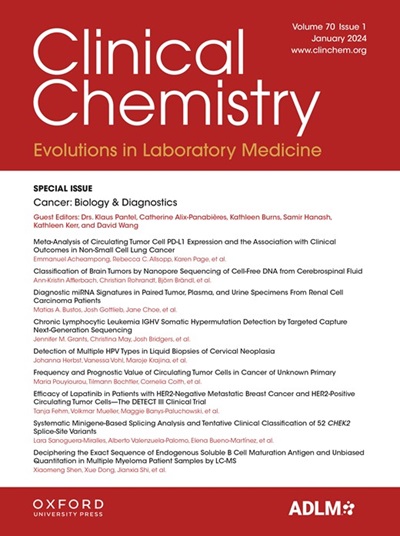A-357 Evaluation of a home kit for lay user collection, centrifugation, and refrigeration of capillary blood specimens
IF 7.1
2区 医学
Q1 MEDICAL LABORATORY TECHNOLOGY
引用次数: 0
Abstract
Background While solutions enabling at-home self-collection of capillary blood samples are maturing, many analytes require blood separation and controlled shipping temperatures for stable analysis in centralized laboratories. Here we present results of a pilot lay user study evaluating usability and specimen quality of at-home blood collection with centrifugation and refrigerated shipping of capillary serum specimens. Methods N=45 consented subjects were mailed kits including supplies for a capillary blood self-collection using a Tasso+™ device, a Labcorp TrueTherm™ reusable shipper containing a temperature tracker, a Labcorp TrueSpin™ battery-powered centrifuge, written instructions, and a usability survey. Subjects independently followed the instructions for blood collection, separation, and thermal protection and returned the kits to Labcorp via overnight shipping. Received kits were evaluated for correct return, volume of blood collected, volume of serum, visual hemolysis, and temperature throughout shipment. Results Of the n=45 consented subjects, 39 subjects returned the kits, one subject unsuccessfully attempted to collect blood two times, and the remaining five subjects did not return the kits. Primary analysis parameters are outlined in Table 1. Conclusions Untrained subjects were able to collect their own capillary blood samples, process them, and ship them using the investigational home collection kits. While kit return can be a challenge with home collection, the vast majority of subjects were able to return a testable sample. Combining blood separation prior to shipment using the Labcorp TrueSpin centrifuge and temperature control with the reusable Labcorp TrueTherm device successfully protected samples from hemolysis. These results indicate that such kits are a promising at-home blood collection method and may increase test accuracy and menu availability for sensitive analytes.A-357 评估用于非专业人员采集、离心和冷藏毛细血管血液标本的家用工具包
背景 尽管可实现毛细管血样居家自助采集的解决方案日趋成熟,但许多分析物仍需要血液分离和控制运输温度,以便在集中实验室进行稳定的分析。在此,我们介绍一项非专业用户试点研究的结果,该研究评估了毛细管血清标本离心分离和冷藏运输的居家血液采集的可用性和标本质量。方法 向 N=45 名同意的受试者邮寄了工具包,其中包括使用 Tasso+™ 设备进行毛细管血液自我采集的用品、包含温度跟踪器的 Labcorp TrueTherm™ 可重复使用运输器、Labcorp TrueSpin™ 电池供电离心机、书面说明和可用性调查。受试者独立按照说明进行血液采集、分离和热保护,并通过隔夜运输将试剂盒送回 Labcorp。在整个运输过程中,对收到的试剂盒的正确归还、采血量、血清量、肉眼溶血和温度进行评估。结果 在 45 名同意受试者中,39 名受试者退回了试剂盒,一名受试者两次尝试采血均未成功,其余 5 名受试者未退回试剂盒。表 1 列出了主要分析参数。结论 未接受过培训的受试者能够自己采集毛细血管血样,并使用研究性家庭采血包进行处理和运送。虽然试剂盒返还是家庭采血的一个挑战,但绝大多数受试者都能返还可检测的样本。在运送前使用 Labcorp TrueSpin 离心机进行血液分离,并使用可重复使用的 Labcorp TrueTherm 设备进行温度控制,成功地保护了样本不发生溶血。这些结果表明,这种试剂盒是一种很有前途的居家采血方法,可以提高敏感分析物的检测准确性和菜单可用性。
本文章由计算机程序翻译,如有差异,请以英文原文为准。
求助全文
约1分钟内获得全文
求助全文
来源期刊

Clinical chemistry
医学-医学实验技术
CiteScore
11.30
自引率
4.30%
发文量
212
审稿时长
1.7 months
期刊介绍:
Clinical Chemistry is a peer-reviewed scientific journal that is the premier publication for the science and practice of clinical laboratory medicine. It was established in 1955 and is associated with the Association for Diagnostics & Laboratory Medicine (ADLM).
The journal focuses on laboratory diagnosis and management of patients, and has expanded to include other clinical laboratory disciplines such as genomics, hematology, microbiology, and toxicology. It also publishes articles relevant to clinical specialties including cardiology, endocrinology, gastroenterology, genetics, immunology, infectious diseases, maternal-fetal medicine, neurology, nutrition, oncology, and pediatrics.
In addition to original research, editorials, and reviews, Clinical Chemistry features recurring sections such as clinical case studies, perspectives, podcasts, and Q&A articles. It has the highest impact factor among journals of clinical chemistry, laboratory medicine, pathology, analytical chemistry, transfusion medicine, and clinical microbiology.
The journal is indexed in databases such as MEDLINE and Web of Science.
 求助内容:
求助内容: 应助结果提醒方式:
应助结果提醒方式:


